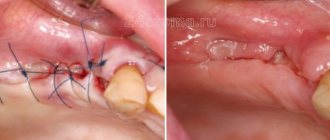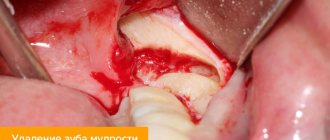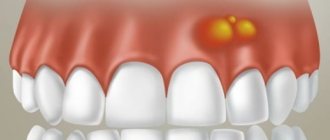Tooth extraction is one of the most popular and simplest operations in medicine. Usually it passes without complications, but due to a number of general or subjective reasons, deviations may occur. One such postoperative complication is dry socket.
The fact is that after extraction of a tooth, a cavity forms in its place, which, in a positive scenario, is filled with a blood clot. It prevents the penetration of microbes into an open wound and promotes its speedy healing. A dry socket after tooth extraction is the absence of that same blood clot in the socket. This can happen for two reasons:
- Loss or resorption.
- Severe bleeding that prevented a clot from forming.
Whatever the reason, the healing process can take weeks and be accompanied by serious discomfort, which is not always possible to eliminate on your own.
Symptoms
Dry socket syndrome is very painful. It is quite easy to identify if the following symptoms appear within 2-3 days after tooth extraction:
- inflammation of the gums, accompanied by severe pain;
- pain in the cervical region and ears;
- the appearance of bad breath;
- taste of pus in the mouth;
- partial hearing loss;
- general malaise
Visually, a dry socket is an empty depression at the site of tooth growth, first exposing the jawbone, and then turning into a reddened, purulent wound.
Normally, the socket is a cavity that, after tooth extraction, is filled with ichor. Over the next three days, the clot thickens, and light fibrin stripes appear on it - the beginning of the formation of new gum tissue. There may be slight soreness at the wound site. From 4 to 7 days, swelling gradually subsides, and the gums acquire their usual pink color. There is no pain.
Healing of the tooth socket after extraction
Tooth extraction is a surgical intervention with the formation of a wound after extraction, therefore, as after any intervention, the wound formed at the site of the tooth must also undergo a healing process, and its tissue must recover and fill the voids. This process lasts for 4 months. The stages of tooth socket healing are as follows:
- a blood clot forms immediately after removal;
- 2-3 days - epithelization of the hole begins;
- 3-4 days - the first signs of granulation tissue formation appear;
- 7-8 days - part of the blood clot is replaced by granulations, gum cells begin to form an epithelial layer; the process of bone tissue formation begins;
- Days 14-18 - granulation tissue completely fills the socket, and the socket itself is completely covered with new epithelium. New bone cells are actively forming on the walls of the socket;
- 1-2 months - active process of bone tissue formation;
- 2-3 — filling the hole with bone tissue; tissue saturation with calcium;
- 4th month - bone formation ends, the structure becomes spongy.
If, when a tooth is removed, a blood clot does not form in the socket, the healing process of the socket occurs thanks to its walls - they are the ones who contribute to the development of granulation tissue. Otherwise, the further stages of healing are the same as those described above.
Healing after removal of an inflamed tooth
We have described a 4-month process of tissue restoration, however, they are restored so quickly only if there is no injury, inflammation or infection in the tooth and surrounding tissues. If the listed processes take place, tissue regeneration does not proceed so quickly. As a rule, it is prevented by the formation and course of the inflammatory process, the time period increases and the stages of healing look like this:
- epithelization and formation of granulation tissue occur in 10-15 days instead of 3-5 days;
- Bone tissue formation begins only on the 15-16th day instead of the 7-8th.
- closure of the hole by the epithelium is 2 times slower and ends only on the 30th or 50th day;
- only at 2 months the hole is completely filled with osteoid cells, which then become full-fledged bone;
The process of epithelium and bone formation can be even longer if the walls of the socket and/or gum tissue were severely damaged during tooth extraction.
Possible complications
Since tooth extraction is a surgical procedure, unpleasant consequences may arise after it is performed—complications of various kinds. In this case, the causes of such complications can be either the patient’s negligence in hygiene after surgery or the incorrect actions of the surgeon. Another category of etiology of adverse consequences is the complex course of the operation (with increased bone strength, non-standard shape or size of the tooth root).
Alveolitis
Alveolitis often forms when, after removal, a blood clot does not form in the socket for some reason. Without a clot, the socket is deprived of a protective barrier from external influences and is therefore susceptible to the appearance of an inflammatory process. The first and main symptom of this disease is pain immediately after removal or after 2 days. There is swelling of the gums, inflammation of the edges of the socket, due to the fact that a blood clot has not formed, the cavity is filled with food, which further contributes to the development of the inflammatory process. Other characteristic signs: temperature, unpleasant odor from the hole, poor health, pain and swelling of the mucous membrane at the extraction site.
The etiology of the development of alveolitis is considered to be an infection caused by oral microbes entering the socket. The body is not able to form a protective barrier in the hole, so inflammation rapidly develops in it.
The following causes of alveolitis are distinguished:
- chronic inflammation in the tissues of the oral cavity, its exacerbation;
- high degree of tissue trauma due to complex tooth extraction;
- a blood clot did not form during or after the operation (for example, due to the patient’s violation of the doctor’s recommendations);
- disorders in the immune system, chronic fatigue, chronic diseases;
- long removal process (longer than 40 minutes).
Treatment of alveolitis
Depending on the severity of alveolitis, both local and general treatment can be prescribed. Local methods are usually used using antiseptic rinsing and treating the socket with an antimicrobial agent. In addition to this treatment, vitamins and antibiotics may be prescribed.
In the case of general treatment, physiotherapy is also added, and the overall period of treatment and healing of the hole is increased.
Socket bleeding
Bleeding can occur both immediately after the operation and some time after the operation: from 1 hour to 24 hours or more. The period of manifestation of alveolar bleeding varies depending on the reasons that cause it. An earlier manifestation may be caused by vasodilation, later - due to injury to the socket by the patient after surgery. However, the etiology of the complication may also include injuries during removal (gums, alveoli, blood vessels) and diseases of the body (sepsis, hypertension, leukemia, the first 2 days of the menstrual cycle in women, taking aspirin and its analogues, diabetes).
The process of preventing bleeding depends on what causes it: local causes are eliminated by applying sutures to the rupture sites or applying cold, using a tampon. If the bleeding is caused by low blood clotting, medications are used to increase clotting.
Paresthesia
Sometimes after tooth extraction, patients complain of numbness in the oral cavity. Symptoms can be expressed over a period of 1 to 30 days or even more. The cause of paresthesia lies in nerve damage. Dentists can speed up the restoration of damaged tissue by prescribing vitamins B and C to the patient in combination with injections of galantamine and dibazole.
Neighboring teeth change position, Popov-Gordon effect
The body does not tolerate emptiness, therefore, after a tooth is removed and there is no analogue in its place for a long time, the neighboring teeth (and the tooth on the opposite jaw) tend to fill the resulting space, leaning towards the socket. Obviously, in such a situation, the dentition changes, which leads to curvature, changes in chewing load and bite.
The problem can be solved by replacing the missing tooth with an analogue after the hole has healed and tissue restoration: an implant, a prosthesis.
Communication of the oral and nasal cavities
When extracting molars and premolars of the upper jaw, the floor of the maxillary sinus may be injured, which will lead to the formation of a connection between the oral cavity and the nasal cavity.
It is noteworthy that this complication occurs even if all actions were performed correctly by the dentist. Its causes are usually:
- absence of a bone septum or close adherence of the roots to the sinus;
- bone destruction due to chronic inflammation in the area of the apex of the tooth root;
The complication requires surgical intervention by a specialist, since the entry of food and drink into the nose through the oral cavity usually leads to inflammation in the sinus (sinusitis), which in itself is a very unfavorable consequence and requires long and complex treatment.
Intervention is not carried out only if acute purulent sinusitis of the upper jaw has developed.
Other complications
Other complications are caused by: incorrect actions of the doctor and the characteristics of the patient’s body.
First category of reasons:
- improper use of forceps and, as a result, damage to the crest of the alveolar tissue;
- erroneous extraction of a tooth germ due to the ignorance of the doctor during milk extraction;
- injuries to adjacent teeth due to careless work of a dental surgeon;
Second category of reasons:
- weak or defective teeth located nearby may break during surgery on the causative tooth;
- low strength of the causative tooth, which causes its fracture and the need to remove parts;
- weak jaw tissue, which increases the risk of fracture and complications;
- individual features of the structure of the roots, jaw and location of nerves.
Rules of care
To prevent complications due to the patient’s fault, it is very important to follow all the dentist’s instructions, namely:
- The first day after surgery: keep the installed tampon in the mouth for 30 minutes, do not eat for 2 hours; do not load food and do not touch the socket area with your tongue or toothbrush;
- 2-3 days after surgery, minimize the load on the teeth located in the extraction area, limit the intake of solid and hot foods, giving preference to soft and liquid foods;
- Refrain from smoking (to prevent a vacuum from occurring in the socket) and try not to drink alcoholic beverages;
- Buy a soft toothbrush to gently clean the area of the extracted tooth a few days after the operation; in the first days it is better not to brush the injured area at all;
- The next day after the operation, make oral baths for the socket (do not rinse under any circumstances) with warm salted water (but not with special rinses).
- Do not exercise for 2-3 days;
- Do not take a hot bath on the first day after removal;
- Do not take aspirin and its analogues.
Causes of dry socket
There are several causes of dry socket. Some of them can be prevented by following simple recommendations regarding personal hygiene and caution. Causes:
- smoking. In this case, there is a decrease in pressure in the oral cavity, which can lead to the loss of the formed clot;
- neglect of oral hygiene;
- low blood clotting;
- taking oral contraceptives;
- mechanical damage to the hole itself or the tissues around it.
In addition to the above reasons, a dry socket can appear as a result of an incorrectly performed tooth extraction procedure. During a complex extraction, when the tooth had to be removed from the gums in parts. All rules recommended before and after extraction must be followed.
How to remove suture threads from a tooth socket
Many people associate the removal of sutures with unpleasant pain. Pain occurs only in people with a low pain threshold, increased sensitivity, or when there is inflammation in the tooth socket. Usually the patient experiences only discomfort.
Stages of removing suture material:
- treating the patient's oral cavity with an antiseptic;
- examination of the mucous membranes for hyperthermia, swelling, suppuration;
- the use of topical anesthesia to prevent even minimal pain;
- cutting the threads with a special dental instrument - the stitches are divided in half, especially in the case of an intermittent suture line;
- removing pieces of thread with tweezers;
- checking the density of the scar and the quality of wound healing.
Next, the patient will be asked to rinse his mouth with an antiseptic composition.
The first three days after the stitches are removed, stiffness of movements and discomfort when opening the mouth are possible.
Consequences
If during the first two days after tooth extraction pain appears, swelling does not subside and the temperature rises, then most likely these are signs of inflammation. In this case, you should immediately consult a doctor, as dry socket syndrome can lead to serious complications. Such as:
- flux.
It begins to form when an infection gets into the hole. Characterized by severe swelling and pain. Requires immediate specialist intervention. - alveolitis
This is a deeper penetration of the infection - deep into the gums. Bacteria spread quickly and, if this process is not stopped in time, there is a risk of tissue necrosis. In this case, the losses can be very serious.
Attention!
The consequences of untimely or incorrect treatment can be irreversible. Do not neglect your doctor's advice. A wound on the mucous membrane is always a vulnerable area, subject to attack by bacteria and their rapid spread.
Emergency help for a festering hole
Many people are interested in the question of what can be used to treat an inflamed wound if for some reason there is no blood clot, and it is not possible to see a doctor in the near future. First, it’s worth saying that such a complication can become very dangerous, so you should never hesitate to visit a specialist. But until this moment, you can try to alleviate your condition with home methods. This can only be done with the permission of a specialist, so it is better to contact your doctor at least by phone. You also need to understand that independent attempts to relieve acute symptoms cannot replace full treatment.
Important! In many sources you can find information that it is best to treat the hole with a soda solution and hydrogen peroxide. However, most experts strongly discourage these products. Despite their antiseptic properties, soda and peroxide instantly wash out the blood clot, and the wound becomes defenseless against infection.
So, if the wound festers and bleeds, you can resort to the help of natural antiseptics. Decoctions and infusions of medicinal herbs such as chamomile and sage help relieve swelling and reduce inflammation. To prepare the product, just take a tablespoon of the dried and crushed plant, pour a glass of boiling water and let it brew for 20-30 minutes. After this, the broth should be filtered and then it can be used to gently rinse the inflamed area.
Chamomile infusion is great for rinsing
Forms of alveolitis
Depending on the course of the complication, three stages are distinguished:
- Serous.
It makes itself felt
2-3 days
after tooth extraction. At this stage, pain occurs when eating, headache. Lymph nodes increase in size. - Purulent.
This is the next form that occurs after the serous one, if timely treatment is not carried out. Diagnosed a week after the tooth was removed. The pain becomes unbearable and is also felt in the head or ear. The hole becomes covered with a purulent, dirty yellow coating. There is an unpleasant odor from the mouth. Swelling and lymph nodes enlarge and become painful. Opening your mouth and eating food is extremely difficult due to pain. - Hypertrophic.
At this stage, it seems that the symptoms are subside: the condition is normalized, the temperature decreases. However, atrophied tissue grows, and when pressure is applied, pus is released from the inflamed wound.
If you notice any of the above symptoms, you should not self-medicate, but rather consult a dentist.
How long does the healing process take?
If the tooth is removed efficiently, then normally the healing speed does not exceed more than 2.5 weeks. The speed of regeneration depends on the location of removal. In case of amputation of a single-rooted tooth, the wound should heal within 2 months. In case of wisdom tooth removal - a little later, after 2.5–3 months. During this time the following happens:
- tissue restoration and regeneration:
- formation of the bone shell.
If the extracted tooth leads to rupture or injury to the surrounding tissues, the formation of a hole with torn or far apart edges, then the process will take longer - up to 1.5 months, until young bone tissue grows and the gum cover is completely formed.
Why is the process taking so long?
The hole takes a long time to heal and heal after tooth extraction, sometimes due to the fault of the dentist when carrying out incorrect manipulations, failure to comply with sanitation conditions, leaving food particles or bone fragments that can lead to the development of an inflammatory process and suppuration. When the gums heal slowly after tooth extraction, the patients themselves are usually to blame and the reasons for this are:
- frequent rinsing of the mouth, washing out blood clots from the wound, when there is a high probability of re-infection when germs and bacteria penetrate into the hole;
- excessive trauma to the socket due to eating solid food or brushing teeth with non-sterile hard toothbrushes;
- taking medications to thin the blood;
- diseases - diabetes mellitus and poor clotting.
It is the formation of blood clots in the formed hole that is protection and cover from the entry of microbes, stimulation for the restoration and regeneration of damaged tissues. The entry of foreign particles into an injured socket can lead to inflammation, delayed healing and suppuration, and the development of pulpitis, gingivitis, and stomatitis.
If the bleeding does not go away after 2-3 days, the gums do not heal for a long time, and there is a putrid smell from the mouth, then it is better to visit the dental office again and consult with a specialist.
Diagnosis and treatment methods
Diagnostics at a dentist's appointment will help confirm the symptoms of a dry socket. After an examination, the doctor will prescribe treatment. As a rule, it depends on the stage of inflammation. In the case of a mild form, drug treatment with antiseptics and anti-inflammatory drugs is possible. At the middle stage, you will need antibacterial therapy, as well as cleaning the hole from pus and filling it with an anti-inflammatory drug. All actions are performed under anesthesia. If necessary, antibiotics are prescribed.
At the third stage, the most advanced stage, the patient may need hospitalization and even surgical intervention. With proper care and no complications, the hole heals within seven days. And a month later there is no trace left of her.
Causes of periostitis
Experts explain the occurrence of flux by the activation of pathological microflora, which is in a dormant state. The main risk factors include:
- complex and traumatic tooth extraction;
- incomplete extraction of the root from the bone tissue;
- atraumatic surgery for tooth root extraction.
In most cases, the disease develops after the spread of purulent infection from the periodontal gap of the causative tooth into nearby bone tissue.
Features of wisdom tooth removal
Dry socket after wisdom tooth removal is not uncommon. This syndrome occurs especially often in the lower jaw due to the fact that as a result of swallowing and opening the mouth, the muscles tense, aggravating the appearance of a dry socket and, as a result, alveolitis. Dry socket occurs in approximately 50% of cases
. Due to the anatomical features of the jaw, the blood clot often falls out.
When extracting a wisdom tooth, you must carefully observe precautions and resort to this procedure only in cases of extreme necessity. After all, the inaccessibility of the place complicates treatment.
How is the removal procedure carried out?
The procedure is always performed under anesthesia, most often local anesthesia. However, if a complex extraction is ahead or the patient has an overwhelming fear of dental treatment, the operation can be performed under general anesthesia or sedation. After the anesthetic begins to take effect, the specialist moves the gum tissue slightly away from the walls of the tooth, and then grabs it using special forceps. If we are talking about the upper jaw, then the doctor presses on the instrument with his entire right hand. When it comes to dealing with the lower tooth, the specialist also works with his right hand, but mainly with his thumb.
This is how a tooth is removed
Read more about how the procedure for removing upper teeth differs from the technique of extracting teeth from the lower jaw in our special article>>>
To extract a tooth from the gum and bone tissue, it is necessary to dislocate it. To do this, the doctor makes rotational and oscillatory movements. Regarding what is placed and what is used to fill the cavity after the hole is emptied, no specific manipulations are required here. The doctor only applies a sterile cotton swab to the wound, which must be held in the mouth until the bleeding stops completely. If a complex removal, for example, of a wisdom tooth, has been carried out, it will take more time for the tissue to heal, because the gum is first cut and then sutured, and this involves even greater trauma to the mucous membrane.
Next, the specialist gives important instructions on how to care for the hole and how to rinse it, tells how long it takes to heal and what to do if the wound does not heal for a long time. You need to listen to the dentist very carefully and then strictly follow his recommendations - this is the only way to protect yourself from the development of complications.
Treatment of dry tooth socket at home
If the pain from dry socket inflammation is too severe, you can take painkillers. In the first two days, apply cold compresses to the inflamed side at intervals of 20 minutes, then change to warm ones.
Drink more fluids, especially water. It removes harmful substances from the body. Avoid alcohol.
Rinse your mouth with a salt water solution. This clears the wound of dead cells and relieves inflammation. But you should not apply pressure in the area of the hole - you can provoke the displacement of the blood clot. You should rinse your mouth after every meal and before going to bed.
You can also apply a drop of clove oil to the wound to relieve pain. Rinsing with sage and chamomile flowers, a decoction of burdock leaves and aspen bark, and anise infusion will also have a positive effect.
If after all the treatments the pain has not subsided, the swelling has not subsided, and your health has only worsened, then you should urgently consult a doctor. There is a high probability that the process of rotting has begun.
In the dental office, the doctor, under anesthesia, will clean the hole or prepare the gums - depending on the degree of neglect of the case. Fill it with antiseptic gel.
How does the regeneration process proceed after extraction of the “eight”
The socket of an extracted wisdom tooth is always deep. This is due to the structural features of the “eights” - they have tortuous and long roots, which cannot be extracted from the gum tissue atraumatically. Blood flows from the wound for some time. This is due to the rupture of local microvessels. Then she curls up. Then a dense blood clot forms. It is needed to protect tissues from infection.
After the operation, the doctor applies a sterile gauze swab to the hole. To fix it, the patient must close his jaws. This helps stop bleeding as quickly as possible. You need to keep the tampon in place for as long as your doctor tells you. Under no circumstances should you spit it out at the first opportunity.
In the first two days, the clot filling the hole has a rich burgundy color. Under no circumstances should you touch it, let alone try to remove it. It serves as a barrier that prevents germs, bacteria and food debris from entering an unhealed wound.
Starting from the second or third day, the appearance of the clot changes. A light coating forms on its surface. Many people get scared because they think they are releasing pus. There is no need to worry - this is a normal process. The change in the shade of the socket is associated with the formation of new protective epithelial tissue, the basis of which is fibrin protein.
Gradually, the clot dissolves on its own and disappears. A healthy pink mucous membrane is found underneath. This indicates that regeneration was completed successfully.
Prevention
Preventing dry socket is always easier and cheaper than treating dry socket. To do this, you need to follow a number of preventive measures. Namely:
- If possible, limit physical activity for several days after tooth extraction;
- do not touch the removal site with your hands or tongue;
- do not chew on this side;
- eliminate the use of tobacco and alcohol;
- do not eat too hot, cold or spicy foods;
- It is advisable to grind food into puree.
Expert of the article Bolshakova Evgenia Vladimirovna Dentist-hygienist
More than 11 years of experience
Indications for removal of eighth teeth
wisdom teeth
- A pronounced tilt of the figure eight towards the seventh tooth or cheek.
- Hypercementosis (excessive deposition of secondary cement, in which the tooth root thickens and becomes deformed).
- Incomplete eruption of the tooth or its location in the bone (retention).
- Destruction of the crown or roots of the figure eight, as well as neighboring teeth (after injury or caries).
- Granuloma (granulation in the form of cystic sacs with pus located in the periodontium).
- Rotation of the tooth around its axis or horizontal position (dystopia).
- Deformation of the roots (they can bend in every possible way, even twist into a spiral or form an angle of 90°).
- The close location of the roots of the upper eights to the nasal maxillary sinuses.
- In the presence of pericoronitis (an acute inflammatory process in the area of the eruption of the figure eight, accompanied by pain and an increase in ESR in blood tests).
Treatment in the clinic
The optimal solution for treating a diagnosis of dry socket or alveolitis is a visit to the dentist. It is better to go to the same doctor who performed the tooth extraction, since he already knows the course of the operation, did the diagnostics and remembers the characteristics of your body.
Whatever clinic you choose to contact, study its website, the doctors who work there and reviews.
At the RUTT dental center we use the latest equipment and advanced materials. The experience of our doctors is confirmed by numerous diplomas, certificates and awards. You can be sure that you will be in the hands of a reliable specialist.
Root removal
How is the root of a tooth removed if the tooth is completely destroyed? Despite this situation, extraction is not always recommended. If, after diagnosis, the doctor determines that the root can be used for an inlay, then the tooth is restored with a crown. But if there is pain, an unpleasant smell and taste, or swelling has developed, then dental care is required urgently. In this case, the question of whether to remove the roots of the teeth is decided in favor of the operation, since the neglected condition can also lead to the loss of neighboring elements.
Regardless of the chosen technique, pain relief and X-ray control are required after removal. This allows you to make sure that there are no root fragments in the cavity, since it is often loose and can crumble under slight pressure from the forceps.
Flux after tooth extraction, what to do, how to treat?
The doctor begins treatment for the disease only after a thorough diagnosis of the affected area. To do this, the patient is prescribed an X-ray examination, which makes it possible to determine the presence of root fragments after the operation of its extraction.
For purulent inflammation of the periosteum, treatment occurs on an outpatient basis. The patient must undergo the surgical stage of therapy in the clinic, and further drug treatment is performed at home.
Conservative therapy consists of taking antibiotics. This course of antibacterial action lasts at least seven days. Systemic administration of such drugs helps to subside purulent processes and transition the acute phase to the chronic phase.
Radical intervention for periostitis is carried out in the form of dissection of the gums, periosteum and installation of drainage for the outflow of purulent masses from the affected area. All surgical interventions are performed under local anesthesia.
If there are separate fragments of the root in the alveolar process, the dental surgeon must proceed with a repeat operation to remove it. In most cases, root removal ends with a quick recovery of the patient.











